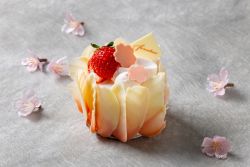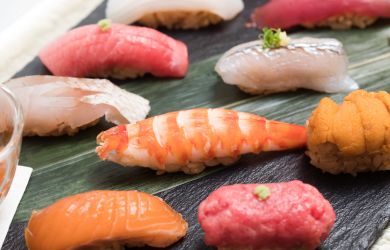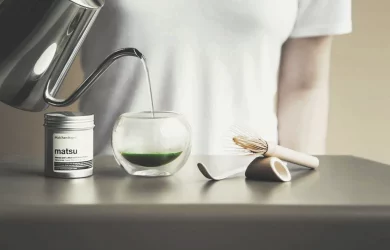
October 22, 2009
Hair Piece
Or, how an unsuspecting foreigner got dragged into a life of close shaves, five-color dye jobs—and the dreaded Persian flaw
By Metropolis

The author is readied for competition
While I only learned these specifics later in my relationship with Hiroyuki, it is important to understand their role in shaping the commitment I observed that and every other night. Even though I had no clue about what the stylists were up to, it was clear that, for a few hours every week, I was in a position to help someone striving to improve his skills, pocket a few yen, and have my hair taken care of. Beyond that, the whole thing was too weird to turn my back on. In the presence of Hiroyuki, under the gaze of his Master, I would utter “Whatever, dou demo ii,” and ask only that he not cut me in the process.
Hiroyuki works fast. His performances in various national competitions would total little more than an hour per year, but only months of practice would make that time worthwhile. However, there are only so many hours in an evening, and only so much tolerance I have before I need to head home or become too drowsy to be cooperative (if Hiroyuki could, he’d keep going when I’m asleep).
The sessions start with a shampoo, then my face goes under a towel as Hiroyuki’s fingers rake my scalp. What follows is an exceptionally careful styling with blow dryer and brush, requiring him to intersperse little breaths of cool air to protect the roots. The final “setting” session is accomplished with lower-heat blowing, strange waxes, and increasingly refined brushes as Hiroyuki comes to guide each hair to its proper place. My job is to keep low enough in the chair for him to work effectively and maintain or release the position of my head in accord with his wishes—difficult at first, but near-telepathic toward the end.
We might talk or share some jokes, but typically it was Hiroyuki plowing through two, three, or four total cycles of styling as I thought about days previous or ahead. Sometimes I was able to read part of a book or catch up on news through my cellphone, but more often than not, effective practice required my attention as well. Near the end of the session, my thoughts veered towards food, and the disbelief that I was caught up in this ordeal. When the weeks before competition arrived, it was pretty much this last thought exclusively.
What had begun as practice sessions occurring once or even twice a week had now progressed into demands of three, four, or even nightly sessions. Hiroyuki would drive me back home, as the trains had stopped running by the time we finished. I was eating late, getting into bed around 2 or 3am without even a chance to check my email, and when I had a vacancy in the hours between work and practice, could find no real comfort. Hiroyuki was drained as well—his hands never resting, they would be nicked and scratched from small errors, and acquire a pale dampness from so many hours spent in water and soap. I recognized these hands from my days as a dishwasher, and respected his effort, even if the sight of his fingers made my own itch.
Sometimes, The Master would be held up, so we’d have to sit with my hair all styled up and nothing further to do, waiting for the consultation necessary for Hiroyuki to improve. Unable to perform, the stylist would feel the exhaustion catch up with him as I offered words of encouragement, myself unable to avoid fatigue. I was always forgetting or misplacing things throughout the day now, and the one night I did manage to catch the last train, I lost my iPhone. Resentment set in as I thought of my life outside of the barber’s chair in the days prior to competition.
After countless hours of styling, consultation and conversations convincing me (and sometimes him) to keep coming back the next day, we finally packed up and headed downtown for the big event: the CNC Japan Hair Design Contest, to be held at Sumida Sangyo Kaikan in Kinshicho. We had a busy two days in front of us: a whole night of four-stage coloring treatment, the fitting of my apparel (a combination of one of my own suits and their sequined jackets and tie; these latter items cost nearly ¥30,000) and rehearsal sessions done in company with The Master. During these times, there would be another barber and his model with us, but they shared little if any verbal exchange as they were competing in another category. We would wrap up just past midnight, grab a curry or gyudon, and then take a few minutes in a capsule hotel’s sento before bedding down for three hours.
In the morning came maintenance checks of all equipment to be used that day: scissors, combs, brushes, dryer, waxes, and me. I’d get my hair done (though without any of the wax or fixing agents), have my eyebrows shaped, get my beard trimmed into something dangerous, and put on make up with foundation, eyeliner, and concealer. All this would leave me looking like a cross between Ziggy Stardust and Frankenstein. On the train from Ikebukuro to Kinshicho, I don’t recall anyone making direct eye contact with me.
Classic Cut Style was one of the last of the six competitions, and we arrived accordingly, missing nearly half of the early events. Hiroyuki escorted me through registration, then onto the main floor for a few seconds of observation and support for his team, and finally into the line where I would receive instructions for my Persian flaw. There was rarely a moment to snap a photo or have a word, and I was taken by surprise when I soon found myself walking onto the competition floor with my fellow models. Hiroyuki and the other stylists were already waiting for us, politely offering their greetings and holding our aprons anxiously at their sides. Shortly after sitting down, the announcer would give word that competition had started. We had just 25 minutes for everything to be perfect.
I sat still, without a mirror, and tried to encourage Hiroyuki through sheer force of my glare; Hiroyuki, in turn, was sweating through his shirt and aged a year right in front of me. Sometimes I could tell something went wrong, perhaps beyond recovery; other times, he would style without err. I looked to the people around me hoping to find some clue as to how he was doing, and found nothing. I tried not to sweat.
When the bell rang and time was up, my job was to sit prominently in the viewing area for some 40 minutes. I held my glare and felt my forehead go hot and cold as the exertion of keeping my expression fatigued the various muscles of my face. I counted to numbers in the thousands. Then, after the patterns of wallpaper started swirling and stopped and started again, after the itch on my brow began to burn, we were asked to stand up, given thanks, and relieved of service. It was over.
Holding my hand at the wrist, Hiroyuki led me back through some blank corridors to a hallway where scissor companies were giving demonstrations on “gliding spiral cuts” next to brass calibrated combs. In this room, we’d meet the other members of his dojo, who received us without any reaction other than “Otsukaresama deshita.” Our various belongings accounted for, we made our way to the main hall for the awards ceremony, which wouldn’t actually get going for another two hours.
While silently sitting next to Hiroyuki, I sensed that he had been unable to read the competition’s performance. Somewhere in our hours of practice, the pursuit of the ephemeral Classic Cut Style had deviated to a series of his own personal challenges—of getting the front just so, or getting the sides straight quicker. Although he met these challenges in time, they did not lead him to victory at this level. We looked on as the awards for technical competitions were given, followed by women’s styles, 3-Ation (think Daigo) and Evening Style.
Now, Hiroyuki straightened up as someone we’d shaken hands with earlier took the stage. This man was to announce the three winners of the Classic Cut and Style. But unfortunately on that day, there would be no reason for us to get up and approach the podium…
Hiroyuki and I would compete in another competition several months later; I would meet his parents, see The Master several more times, and realize I had developed tinnitus. My girlfriend continued to deal with my absurd schedule, but my private teaching lessons fell by the wayside. I had to explain to my teachers and students why my hair was black now, and weeks later, why it was red and purple in the light. I’d meet another foreign model.
When I walk through the city at night, I’ll often pass salons—as any of you might—and see young men and women working their mannequin heads or practicing on each other late into the evening. Not having been in their shoes, I still can’t truly say what it’s like to attempt to define someone’s appearance through a pair of scissors, and furthermore define your own life through the same instrument. But when I look through those windows now, I do understand what they’re trying to do, and to them I can only say “Good luck.”





